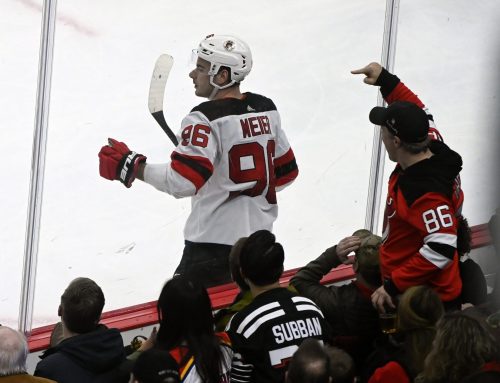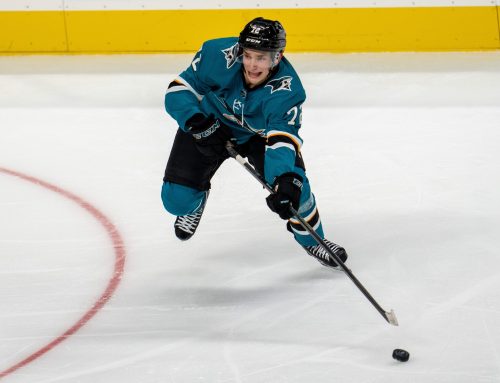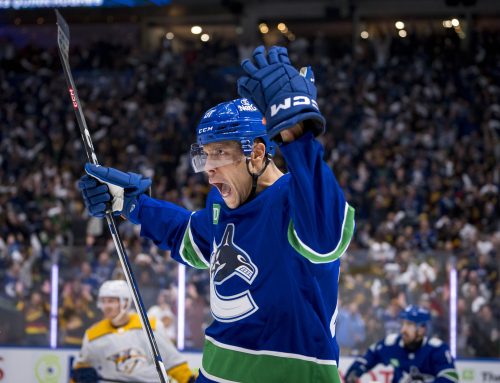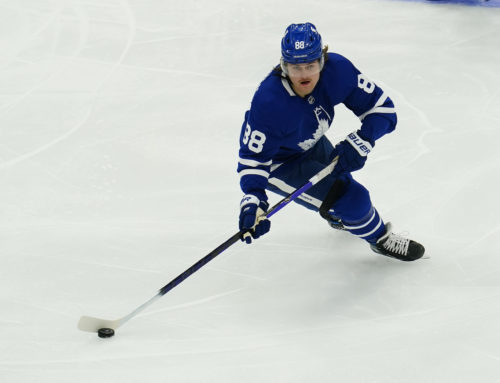Ramblings: Theodore and Schmidt; Ovechkin, Carlson, and Oshie – August 12
Michael Clifford
2017-08-11

Looking back to the expansion draft, one of the more discussed situations was what would happen with the Washington Capitals. I think most people expected one of Philipp Grubauer or Nate Schmidt to be on their way to Las Vegas for the 2017-18 season, and it ended up being the defenceman. He was signed a week ago to a bridge deal of two years with an average annual value of $2.225 million.
To jump into the real hockey real for a minute, I’m not sure a bridge deal here makes sense. He is not really a young defenceman, having turned 26 last month. Should he perform to expectations – which would probably be a solid second-pair defenceman – then he’ll be in for a hefty raise in two years. At that point, giving a hefty raise to a second-pair defenceman going into his age-28 season is probably ill-advised.
For fantasy, I’m curious to see if he emerges as the go-to on the blue line for Vegas. While that roster is, at this point, mostly devoid of high-end skill, they have enough to put together a solid top power-play unit. But is it a four-forward unit, or a three-forward one? It’s worth noting both Schmidt and Shea Theodore are left shots, which means depending on what the coaching staff chooses to do, they are likely interchangeable.
It will probably be a frustrating situation for fantasy owners, but the upside is that I don’t think any of the Vegas defencemen will require a significant investment at the draft table. Selecting either of those two will be less of a cornerstone of a roster (unless it’s a huge fantasy league) and more of a lottery ticket. Theodore may be the heir apparent, but it could be a fluid situation all season unless one stands out clearly above the other.
****
Throughout the summer, I’m going through each team, one at a time, to discuss their fantasy-relevant performers from 2016-17. We’re almost at the end of the list, and the next team in order is the Washington Capitals.
I’m going to avoid writing about Nicklas Backstrom and Evgeny Kuznetsov in this Ramblings. Obviously, they are two key cogs of the Washington attack, but I wrote at some length about them back in June. To summarize, it’ll be hard for Kuznetsov to consistently reach his fantasy potential with Backstrom on the roster ahead of him, but I urge readers to go and read that piece.
It was the 12th consecutive season with at least 30 goals for Ovechkin, which is very impressive as a standalone. It was also the second-lowest goal total of his career (33), the third-lowest point total of his career (69), and the first time in his career he averaged fewer than four shots on goal per game (3.82). What is very concerning here is that he also averaged nearly three fewer total minutes of ice time per game (18:22) than he had up until last season (21:18).
We have seen Ovechkin struggle before, as he did when Dale Hunter took over as head coach in 2011-12. This was different, though. In 2011-12, Washington was 14th in the league in goals for per game; last year they were third. It wasn’t a stifling system that prevented Ovechkin from reaching his potential, it was a huge loss in ice time and, dare I say, age-related decline?
Let’s talk about that age-related decline. It might surprise some people given his final totals, but Ovechkin set a three-year high in points per 60 minutes at five-on-five with 2.19. While he wasn’t the shot attempt leader he was even a year ago on a per-60 basis, he still finished second in the league in this regard. Also, the league as a whole is trending down with regards to players with monster shot attempt numbers:
file this under "interesting but I'm not sure why"
# of fwds (min. 1000 5v5 mins) w/ 20+ iCF/60 is in decline pic.twitter.com/QaAEMwq8cs
— Michael Clifford (@SlimCliffy) August 11, 2017
It should be noted that the stability in points per 60 minutes was largely because of T.J. Oshie. The Yoshi shot an astronomical 26.14 percent at five-on-five this year (and I’ll get to him later), and Ovechkin assisted on 10 of his five-on-five goals. Ovi assisted on no more than six of anyone else (Backstrom), and the next-closest was three (Justin Williams). As Oshie’s shot percentage declines significantly next year, as likely will Ovechkin’s assist rates to him.
Even if we can take off half of his assists from Oshie’s goals, that would have still given him 36 five-on-five points, one shy of his total from 2014-15. In all, it’s still not a huge decline.
The bigger concern is the loss in ice time. Shooters shoot, and Ovi will still get his fair share, but if his ice time doesn’t increase, it’ll be hard for him to regain his former fantasy glory. Consider that over the last four seasons, there have been just three instances of a player managing under 1500 total minutes of ice time, and cracking 80 points. Last year, Ovechkin was given 1506 minutes of ice time. With him not being a playmaker, he’s reliant on goals, and getting close to 50 goals again with that amount of ice time is incredibly difficult. Though he might not be in full decline, with his ice time diminishing, it’s enough to keep him from being in the absolute elite tier of fantasy options.
It is probably easier just to go through Oshie’s season in bullet form because it was ridiculous in every sense of the word:
- In the last 100 years, there have been 137 instances of a forward playing fewer than 70 games and scoring at least 33 goals, as Oshie did in 2016-17. He was just the fourth to do so since the 2012 lockout season, and the ninth since the 2005 lockout.
- Of those 137 instances, 91 of them have come since the NHL started keeping track of shots on goal in 1967-68. Of those 91 forwards for whom we have shots on goal recorded, Oshie is one of four to do so with fewer than 150 shots on goal, and the other three came in the 1980s.
- His aforementioned 26.14 percent shooting at five-on-five was tops in the league, nearly 2.4 percent clear of Paul Byron, and nearly 16 percent higher than in 2015-16. That difference between the two seasons (15.69 percent to be exact) would itself have been top-20 in the league last year among all forwards.
To say that he’s going to regress is true, and the question is how much.
His individual high-danger shot attempts increased on a per-minute basis, but the rate of increase (just over 10 percent) doesn’t come anywhere close to accounting for his goals increase. Maybe he was more selective, but his total shots on goal per 60 minutes fell below 6.00, under notable non-shooters like Jussi Jokinen, Blake Comeau, and Brandon Sutter. Even working with the understanding he’s an above-average shooter, so few shots is going to be detrimental next year.
Let’s be generous and give him an 80-game season next year (which is his career-high), the 12 additional games will provide some cushion for him. It’s a question of how much he shoots; if he gets back to levels from the previous two seasons, maybe he scores 25-30. If his shot level stays where it is and his shooting percentage at five-on-five regresses down to 11 percent, he’ll probably be in the 20-25 range.
Washington lost some weapons like Marcus Johansson and Justin Williams, which assures Oshie stays on the top line and top PP unit unless he has a catastrophically bad season. Being a 55-point player is not a bad season (keep in mind his career-high is 60, and it was the only time he’s had more than 56), but beware of his ADP. He’s not a stat-stuffer in roto leagues, which means he’ll be hard-pressed to be a top-50 forward.
Even though he played 72 games in 2016-17 compared to just 56 in 2015-16, Carlson finished with two fewer points last year (37) than the year before (39). It was a disappointing season for fantasy owners, many of whom probably drafted him as their number-1 defenceman (in 12-team leagues), or at the very lowest a top-end second defenceman.
The addition of Kevin Shattenkirk at the end of February didn’t help matters, that’s true. Carlson managed just seven points in 17 games post-trade, which hurt his overall numbers. It’s not as if he was a big-time producer before that, though, with 30 points in 55 games working out to about 45 points in a full 82-game season. A solid number, but not what owners would be hoping for from him.
Power-play points weren’t really the issue, either. He had 16 such points in 2016-17, the same number he had in 2014-15 when he set a career high in points with 55. The problem, then, was five-on-five scoring. Specifically, it was the lack of secondary assists.
This stat is kind of hard to fathom, but it’s true: Carlson had two (2!) secondary assists at five-on-five last year. He had six the year before (remember, in just 56 games), and 12 the year before that in a full 82-games. His rate of secondary assists was near the bottom of the league, tied with Ben Hutton of Vancouver, and just below names like Jason Garrison and Josh Gorges. Add six or seven secondary assists to Carlson’s final point total, and all of a sudden he’s pushing 45 points in 72 games and his season looks much better.
Eric Tulsky (now working with the Carolina Hurricanes) found years ago that secondary assists are essentially random, but his work was exclusive to forwards. I haven’t been able to find if this is consistent among defencemen or not (if anyone has read anything to this effect, please post it in the comments), but if it is, Carlson would be due for a rebound here.
Maybe Dmitry Orlov can eventually challenge for the top PP spot (which I doubt because he can’t set up Ovechkin for one-timers), but it’s still Carlson’s for now. That cushy slotting, with a (hopeful) rebound in secondary assists could add 10 points to his totals from last year. He should be cheaper at the draft table this year than last, presenting a solid value.
4 Comments
Leave A Comment
You must be logged in to post a comment.





 TOR
TOR BOS
BOS DAL
DAL VGK
VGK EDM
EDM L.A
L.A COL
COL FLA
FLA T.B
T.B VAN
VAN WPG
WPG NYR
NYR ARI
ARI

I think the Nate Schmidt deal is about setting him up to be a really attractive trade piece for a team close to the cap.
How has George McPhee already not been fired after drafting that debacle of a team…I mean passing on Grubauer, Mrazek, and not taking full advantage of the Ducks, Wild etc etc.
Remember, it’s not just about the players McPhee puts ON the ice, it’s also about OTHER assets…such as high draft picks…that McPhee has cleverly acquired that’ll help Vegas build over the next several drafts. So far, so good, George!
He did fine. He was never going to take “full advantage” of teams in bad positions for the draft, because that’s a good way to isolate yourself from those teams. He pretty much said that he had discussions with every team before making his selections, and my guess is that the teams in bad spots made some “gentlemen’s agreements” in order to have Vegas take it easy on them. You may not think that amounts to a hill of beans, but among the very small community that is the GM network, word travels quickly. McPhee earned some favours, of that I am certain.
They also have 27 picks in the next 3 drafts, including 7 (!) second rounders. They have a marketable face in Fleury, a surprisingly decent prospect stock already, and a roster that won’t embarrass itself but also won’t cost them a lottery pick, along with a number of tradeable assets come the deadline (Neal, Perron, McNabb).
The team is in a good position moving forward, with assets befitting a team expecting to compete 5 years from now.